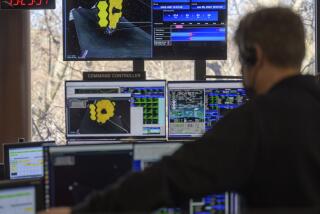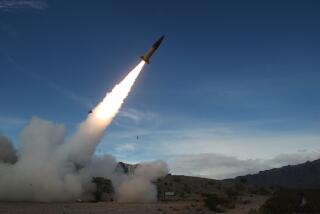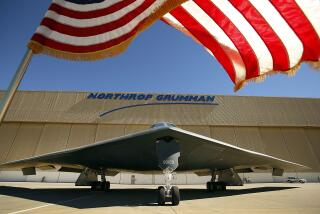Northrop Works for 5 Years on Secret Missile
- Share via
WASHINGTON — Northrop Corp. has been working in total secrecy for five years at its Hawthorne operations on a $15.1-billion program to develop the nation’s most advanced Stealth missile, the Pentagon disclosed Thursday.
The cruise missile, known as the tri-service standoff attack missile, could be launched from the ground or the air at heavily defended targets, and is “stealthier than anything else that we have in the inventory,” said Defense Department spokesman Pete Williams.
Although the existence of the missile was disclosed, few details about the program were released. But defense industry sources estimated that as many as several thousand workers are assigned to the program at Northrop alone. Employment would likely rise once the missile goes into production. Boeing will have a share of the program.
The three armed services plan to build 8,650 of the missiles at $1.7 million apiece, making it the single most expensive non-nuclear missile in the U.S. arsenal. The Navy’s Tomahawk cruise missiles cost $1.3 million each.
The tri-service missile, designated offically as the AGM-137, has a range of 100 nautical miles launched from an aircraft and 270 nautical miles launched from the ground. The ranges were carefully designed to exclude the system from arms control agreements, officials said. The missile flies below the speed of sound and weighs 2,300 pounds.
The disclosure of the massive missile program significantly improves Northrop’s business outlook, which was dealt a serious blow in April after the company lost the contract for the Air Force’s advanced tactical fighter. That program, worth $73 billion, was awarded to a team lead by Lockheed.
A Northrop spokesman said the firm could not disclose employment on the missile program. But based on the value of the contract, the firm could have as many as 3,000 jobs assigned to the effort. Northrop employs 13,000 workers at its Hawthorne-based Aircraft Division, where the missile is under development.
Williams’ announcement came on the eve of the Pentagon’s “Stealth Week,” a weeklong effort to shore up support in Congress for Stealth weaponry with displays and briefings in Washington.
The Northrop missile will be on display in Washington next week, but only for lawmakers and government officials with ultra-top-secret clearances. The Pentagon was unwilling Thursday to disclose the features of the missile or to release photographs of it.
“The timing is perfect to take advantage of the euphoria in this country about the effectiveness of smart weapons in the Persian Gulf War,” said Gene LaRocque, a retired Navy admiral who is director of the Washington-based Center for Defense Information. “While the music of the marching bands is still fresh in our ears, this is a good time to hit up Congress for money.”
Although military officials hope that the missile’s unveiling will bolster support for the B-2 Stealth bomber program, some experts said the cruise missile’s ability to penetrate air defenses raises new questions about the need for the embattled $65-billion B-2.
“They’re going to say this is further indication of the Stealth bomber’s conventional capabilities, but it totally contradicts the Air Force’s entire rationale” for deploying the B-2 as a conventional bomber, said John Pike, a defense analyst with the Federation of American Scientists.
The Air Force, which is managing the three-service program, said that funding for the missile program already is contained in the fiscal 1992 budget request and in projected budgets for future years.
The new missile is designed to be launched from the Army’s Multiple-Launch Rocket System; the Navy’s A-6 attack jet and F/A-18 fighter-attack plane, and the Air Force’s B-2 Stealth bomber, the B-52 bomber and the F-16 fighter-jet, Williams said. Development began in 1986.
Unlike a ballistic missile, which falls freely after it is launched, a cruise missile is powered all the way to its target by a small jet engine. The new tri-service missile would be the Army’s first such missile, and the first such Air Force weapon armed with a conventional high-explosive warhead.
It has long been known that Northrop was developing a secret missile system--originally designated as the Joint Tactical Air Launched Cruise Missile--but securities analysts had little notion that the program was as large as $15.1 billion, or that production would reach as high as 8,650 missiles.
Aerospace analyst Lawrence Harris of Kemper Securities Group estimated that the missile program generated 1990 revenue of $300 million for Northrop, representing about 5% of the firm’s revenues.
“It certainly indicates that there is more to Northrop than just the B-2, which constitutes one-half of the firm’s revenues and 45% of its operating profits,” Harris said. It is not known whether Northrop will locate production of the missile at its new missile plant in Perry, Ga.
Healy reported from Washington and Vartabedian from Los Angeles.
More to Read
Inside the business of entertainment
The Wide Shot brings you news, analysis and insights on everything from streaming wars to production — and what it all means for the future.
You may occasionally receive promotional content from the Los Angeles Times.












